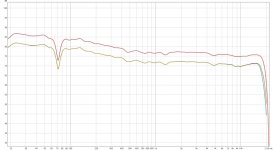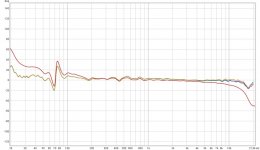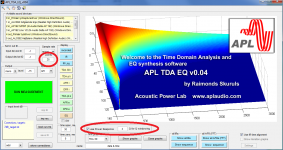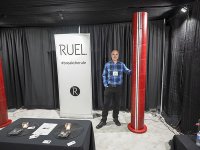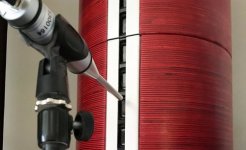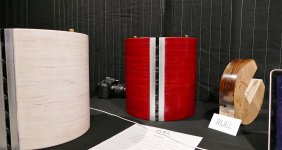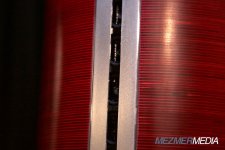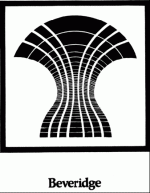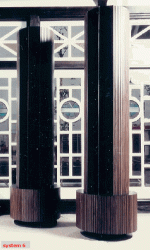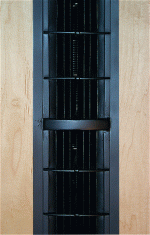I did get some new measurements done today. I've not been able to squeeze in all of the measurements I wanted to do, but hey, it's a start.
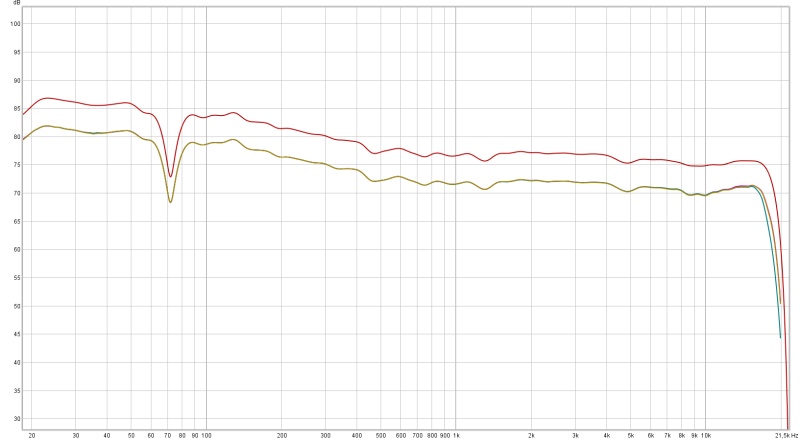
One thing I wanted to check is if the predictions were close to the real life measured results. Meaning I can do some further adjustments off line and still be quite sure the end result will match closely. See the graph above. All traces are presented with a 6 cycle frequency dependent window, the top trace (the prediction from DRC-FIR) is moved up by 5 dB. The bottom traces show 3 separate measurements.
Don't mind the actual curve here, that's my set target from where I begin to adjust with some global EQ.
I'd say the predictability is quite good .
.
The new amplifier is acting way different than my old one. It results in flat phase with my target file, on both sides of the spectrum.
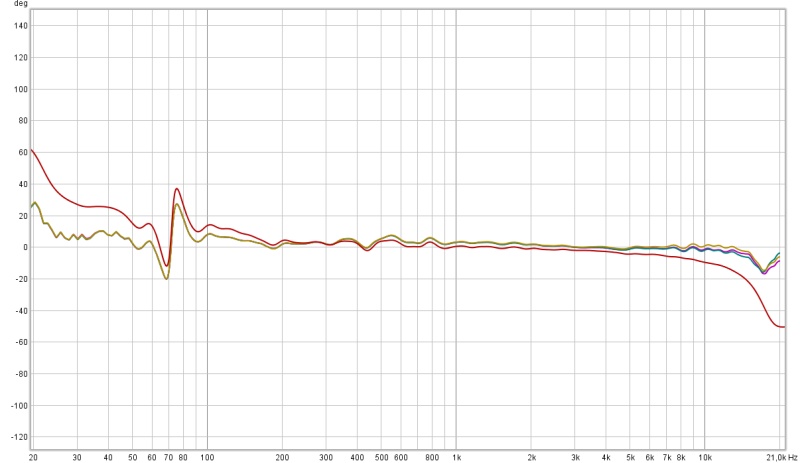
This means to get what I want, I will have to change my settings in the target/template. All in all this is quite different from the old Pioneer.
One thing I wanted to check is if the predictions were close to the real life measured results. Meaning I can do some further adjustments off line and still be quite sure the end result will match closely. See the graph above. All traces are presented with a 6 cycle frequency dependent window, the top trace (the prediction from DRC-FIR) is moved up by 5 dB. The bottom traces show 3 separate measurements.
Don't mind the actual curve here, that's my set target from where I begin to adjust with some global EQ.
I'd say the predictability is quite good
The new amplifier is acting way different than my old one. It results in flat phase with my target file, on both sides of the spectrum.
This means to get what I want, I will have to change my settings in the target/template. All in all this is quite different from the old Pioneer.
Attachments
Progress is slow, the weather still is way too beautiful to sit inside much.
Last week it was the annual TT festival again, another reason not to book any progress .
.
But, I did get something done. For now I'm still only using a single point measurement. Re-creating every thing I did last time. So far I've done the bass management part and checked that. You know, the part where the right speaker covers for the left and vice versa to get a good stereo sum.
On to the next hurdle, checking each step to be sure it works.
Post EQ is next on the list. Another step that will take a while. Especially since I want to check whatever I do against the step before it to learn from it. I gradually rolled into a complete setup that worked well. Redoing it while learning what each step does may give me some new insights.
This is the part where multiple measurements could make a difference. We'll see once I get to try that part .
.
While this all is a slow road, it certainly isn't boring. I found some time this morning to listen to the steps made so far and thoroughly enjoyed it .
.
I compared swapping energy between the left and right speaker using IIR EQ
vs using phase linear EQ. (as that was what I used in the previous setup for the bass tweaks)
Comparing both is was a simple choice. Phase linear EQ for energy swapping wins. It simply sounds the most natural, less forced. (make me want to listen to more and more music)
I used RePhase to make the phase linear EQ tweaks and merged the IR from Rephase with the FIR correction from DRC-FIR.
Last week it was the annual TT festival again, another reason not to book any progress
But, I did get something done. For now I'm still only using a single point measurement. Re-creating every thing I did last time. So far I've done the bass management part and checked that. You know, the part where the right speaker covers for the left and vice versa to get a good stereo sum.
On to the next hurdle, checking each step to be sure it works.
Post EQ is next on the list. Another step that will take a while. Especially since I want to check whatever I do against the step before it to learn from it. I gradually rolled into a complete setup that worked well. Redoing it while learning what each step does may give me some new insights.
This is the part where multiple measurements could make a difference. We'll see once I get to try that part
While this all is a slow road, it certainly isn't boring. I found some time this morning to listen to the steps made so far and thoroughly enjoyed it
I compared swapping energy between the left and right speaker using IIR EQ
vs using phase linear EQ. (as that was what I used in the previous setup for the bass tweaks)
Comparing both is was a simple choice. Phase linear EQ for energy swapping wins. It simply sounds the most natural, less forced. (make me want to listen to more and more music)
I used RePhase to make the phase linear EQ tweaks and merged the IR from Rephase with the FIR correction from DRC-FIR.
The party is over  hope you had some great TT days before lights turned out.
hope you had some great TT days before lights turned out.
Admire your patience and curiosity taking the slow road while learning what each step does/may give, in the past that lead to you shared with us how good it was when system phase follow amplitude as a real IIR device to get rhythm/foot tapping and a analog sound stage that gets under the skin. Thanks for that very good advice where myself had run several local trials upon that scheme for a long time now and i always end up smile whenever i get system calibrated to perform after that receipt, in part of those trials have experienced different DACS have different amplitude verse phase domain than a real IIR domain will dictate and those DACS that sound kind of digital or non engaging will change to marvelous analog performance as soon their differences from ideal IIR domain is corrected somewhere in chain. So ha ha based on your great sharing and own trials predict down the road that this mornings preference for phase linear EQ for energy swapping will change sooner or later to IIR EQ that should repair those phase ripple we can see in above graphs, i could be wrong in prediction but to explain further i base prediction at moment you haven't lined up area above 640Hz point to have phase follow amplitude as in a pure IIR domain which from own trials can totally change how bass area is presented and also your favorite tonality is probably not dialed in yet.
in prediction but to explain further i base prediction at moment you haven't lined up area above 640Hz point to have phase follow amplitude as in a pure IIR domain which from own trials can totally change how bass area is presented and also your favorite tonality is probably not dialed in yet.
BTW with reference to post 3918, for a couple of weeks had been running Seasonic's flagship computer PSU SSR-650PD into computer with ASUS soundcard, was without patience and a bit lazy upon arrival so didn't measure anything but guess my word and subjective experience is also interesting point of view. It didn't completely cure the small level of hum/buzz but level is now only a third of before but best is sound quality is sensed got a small notch better and those small notches is always welcome i think. Next step will be try power ASUS card with some external PSU and see what it gives but problem can also be some loops downstream in multiple power amp section, but lets see down the road in that problem is so low in level I'm not in a hurry because when music streams its a inaudible interference. All in all including better power efficiency that Seasonic flagship PSU seems very good also because it replaced a not very cheap Corsair AX750 which in the past made a huge difference for sound and interference compared to most standard computer PSUs.
Admire your patience and curiosity taking the slow road while learning what each step does/may give, in the past that lead to you shared with us how good it was when system phase follow amplitude as a real IIR device to get rhythm/foot tapping and a analog sound stage that gets under the skin. Thanks for that very good advice where myself had run several local trials upon that scheme for a long time now and i always end up smile whenever i get system calibrated to perform after that receipt, in part of those trials have experienced different DACS have different amplitude verse phase domain than a real IIR domain will dictate and those DACS that sound kind of digital or non engaging will change to marvelous analog performance as soon their differences from ideal IIR domain is corrected somewhere in chain. So ha ha based on your great sharing and own trials predict down the road that this mornings preference for phase linear EQ for energy swapping will change sooner or later to IIR EQ that should repair those phase ripple we can see in above graphs, i could be wrong
BTW with reference to post 3918, for a couple of weeks had been running Seasonic's flagship computer PSU SSR-650PD into computer with ASUS soundcard, was without patience and a bit lazy upon arrival so didn't measure anything but guess my word and subjective experience is also interesting point of view. It didn't completely cure the small level of hum/buzz but level is now only a third of before but best is sound quality is sensed got a small notch better and those small notches is always welcome i think. Next step will be try power ASUS card with some external PSU and see what it gives but problem can also be some loops downstream in multiple power amp section, but lets see down the road in that problem is so low in level I'm not in a hurry because when music streams its a inaudible interference. All in all including better power efficiency that Seasonic flagship PSU seems very good also because it replaced a not very cheap Corsair AX750 which in the past made a huge difference for sound and interference compared to most standard computer PSUs.
Last edited:
So ha ha based on your great sharing and own trials predict down the road that this mornings preference for phase linear EQ for energy swapping will change sooner or later to IIR EQ that should repair those phase ripple we can see in above graphs, i could be wrongin prediction but to explain further i base prediction at moment you haven't lined up area above 640Hz point to have phase follow amplitude as in a pure IIR domain which from own trials can totally change how bass area is presented and also your favorite tonality is probably not dialed in yet.
The above graph was done with partly phase linear correction template. The current template is minimum phase all the way and looks different.
The phase wiggle you see in the left channel is why I experimented with phase linear tweaks. I bring that dip down even more (about 3 to 5 dB) and doing that would create an even bigger phase wiggle. The bump in the right channel (to compensate the total energy) would also make that channel deviate from the desired phase behaviour. So doing this swapping with phase linear EQ prevents further deviations and actually makes the summed Stereo follow minimum phase within it's bandpass
It is the same as what you have heard the two times you visited me. As this is one of the tweaks I have also done in the recent past. This time I intend to do one tweak at a time, and compare it to the previous step.
So I do think it will stand the test of time, at least until I can add the separate subs!

BTW with reference to post 3918, for a couple of weeks had been running Seasonic's flagship computer PSU SSR-650PD into computer with ASUS soundcard, was without patience and a bit lazy upon arrival so didn't measure anything but guess my word and subjective experience is also interesting point of view. It didn't completely cure the small level of hum/buzz but level is now only a third of before but best is sound quality is sensed got a small notch better and those small notches is always welcome i think. Next step will be try power ASUS card with some external PSU and see what it gives but problem can also be some loops downstream in multiple power amp section, but lets see down the road in that problem is so low in level I'm not in a hurry because when music streams its a inaudible interference. All in all including better power efficiency that Seasonic flagship PSU seems very good also because it replaced a not very cheap Corsair AX750 which in the past made a huge difference for sound and interference compared to most standard computer PSUs.
Interesting... keep us posted along the way. Possibly I'm going to run into power supply hum with my future subs. As they will be run from the Asus multi channel card. I did wonder about using an external power supply solely for powering the Asus.
Last edited:
It’s interesting how some accepted beliefs are that the amp topology should not have a big effect on the phase of the measurement. Amps are amps that just boost the signal, or are they? The Goldmund clone is a low global feedback amp and I think the Pioneer is from the height of the era of lots of global feedback amps popular in Japanese amps from the 1990’s. Nice work Wesayso - taking your time and understanding all the nuances is what you do very well.
Thanks can see then that at moment it sounds right using phase linear amplitude EQ because absolut phase also moves by that correction, miss being there under these trials because bet its very interesting and educating steps to learn from.The above graph was done with partly phase linear correction template. The current template is minimum phase all the way and looks different.
The phase wiggle you see in the left channel is why I experimented with phase linear tweaks. I bring that dip down even more (about 3 to 5 dB) and doing that would create an even bigger phase wiggle. The bump in the right channel (to compensate the total energy) would also make that channel deviate from the desired phase behaviour. So doing this swapping with phase linear EQ prevents further deviations and actually makes the summed Stereo follow minimum phase within it's bandpass.
It is the same as what you have heard the two times you visited me. As this is one of the tweaks I have also done in the recent past. This time I intend to do one tweak at a time, and compare it to the previous step...
Come to think about if you curious as i and have the patience and time we could make a offline experiment to see how good TDAeq would repair and correct using pure IIR EQ. All we need is you tell me or post a target curve i can trace to tell TDAeq of target, it should be your favorite tonality curve plus PEQ data for left and right bass area compensation, in you measure at listening position we could try using JBL trained listener curve and then tell me Q and dB numbers for bass area compensation, then i send you a 32bit sweep file and when i get that recording back will have to use some serious hours into Rephase and send back a pure IIR convolution correction to be tested if its hits the planned target. Think TDAeq have some serious adjustable filtering that could be interesting to see the resulting acoustics in your fine electric and acoustic enviroment, it will give me quite some work translate its suggested output over in Rephase but its doable/educating and also find it interesting exercise.
It’s interesting how some accepted beliefs are that the amp topology should not have a big effect on the phase of the measurement. Amps are amps that just boost the signal, or are they? The Goldmund clone is a low global feedback amp and I think the Pioneer is from the height of the era of lots of global feedback amps popular in Japanese amps from the 1990’s. Nice work Wesayso - taking your time and understanding all the nuances is what you do very well.
Hi X down the road try that full blown DSP circus and hear when you correct for a lot of distortions that could be caused by actual using non real linear PSU or motion feedback or bad amp or DAC compensations to stabilize topology or even any small interferences caused by cables, suggest do as wesayso or gmad smooth out even small amplitude wiggles and believe me it works if its based on good measurement and a little less or more patience to find the right reversed repair curve, then in the end look at phase and if any excess to a pure IIR domain correct it or investigate why it is there and let it stay if its because of measurement chain, i know its a lot of work and education and it can take months but it will give more insight and save some money used on endless loop of buying or building new gear. When you reach that magic point one mono speaker or mono into headphones will typical start being close to as 3d illusional and cleaner sound as stereo set could perform before, then turn on stereo and its ala December visit 2016 in wesayso's sweet spot.
I get a little old when you conclude and generalize on amp topology please don't generalize but conclude from case to case when you actual have measured data on a bad unit, i say this because you should change explanation and say many global feedback amps are compensated for stability in a way that make them deviate in phase from being a pure IIR device from input to output, same can be the case for DACS and digital amps but in the case of full blown DSP systems as wesayso's it can be compensated for, also because have fine DC coupled Japanese global feedback amps myself that is compensated by the book showing no excess phase in measurements and when schematic is simulated into Tina-TI it shows a 440kHz bandwidth with a clean IIR phase domain. Admire some of your diy amps and designs because they Class A and have what is told or rumored to be a better distortion profile, that said the ones you compensate by ear can end in same camp as your critics on global feedback amps and deviate phase from a pure IIR domain.
Absolute agree your review below but then think over that the Japanese Pioneer amp get not one word at all but it powered all the acoustics we heard, either it must be a very good amp and it actual was not very cheap and a serious product or it benefit wesayso's clever full blown DSP care so final limited band pass of acoustic speaker domain have corrections for small various amp distortions. If i remember right its bandwidth number is about 160-170kHz and find a year 1990 schematic below, unfortunate because of IC101 i can't easy set it up into Tina-TI for a feel of its phase domain. In its home imagine Pioneer have played very well for many years, it probably just missed the step up of headroom and some bragging rights on par speaker towers it feed.
...So what do the Two Towers sound like?
One word: Uneffingbeliveable.
Hands down the best speakers I have ever heard. Unrivaled by probably 99% of anything out there commercially or DIY...
The most impressive thing about the Two Towers is the whole experience. It's not because any one aspect is good, it's because EVERY aspect is great. The large wide sweet spot, the force of the wall of sound, the low distortion, the accurate deep bass, the sweet smooth mods, the impeccable time alignment and transient perfect nature of the sound, the clear as a bell highs, the superb deep bass down to 17Hz (no subwoofer), the immense feeling of being teleported to the recording venue. It's all there and it all works together to produce what is perhaps, the closest feeling to being there I have felt when hearing speakers. Wesayso worked really hard on the SYSTEM approach so it includes room treatments, convolution processing, rear ambience speakers (10Fs), and careful adjustments.
The system makes any music sound it's best and there is no genre that doesn't sound its best.
Wonderful experience. World class!
Oh, the cabinets themselves are very impressive. I put my ear to the side while they were playing and could not hear or feel any vibrations or sound. Just inert. The hand cut and polished aluminum bezel waveguide is also quite the piece of workmanship...
Attachments
Last edited:
Thanks can see then that at moment it sounds right using phase linear amplitude EQ because absolut phase also moves by that correction, miss being there under these trials because bet its very interesting and educating steps to learn from.
Come to think about if you curious as i and have the patience and time we could make a offline experiment to see how good TDAeq would repair and correct using pure IIR EQ. All we need is you tell me or post a target curve i can trace to tell TDAeq of target, it should be your favorite tonality curve plus PEQ data for left and right bass area compensation, in you measure at listening position we could try using JBL trained listener curve and then tell me Q and dB numbers for bass area compensation, then i send you a 32bit sweep file and when i get that recording back will have to use some serious hours into Rephase and send back a pure IIR convolution correction to be tested if its hits the planned target. Think TDAeq have some serious adjustable filtering that could be interesting to see the resulting acoustics in your fine electric and acoustic enviroment, it will give me quite some work translate its suggested output over in Rephase but its doable/educating and also find it interesting exercise.
Should be fun to try "some day".
Is the window of correction flexible within TDA_EQ? I even have an older version that I never got around to, to really experiment with it. I know new features have been added.
To adjust arrays you'd need at least adjustability of which frequency dependent window to use. As this isn't just one tweeter playing up high.
In defence of the old Pioneer A757 Mark II, it has served me well for many years (bought it new). I'd still pick it over 2 out of 4 amplifiers we tried a few months ago.
But, it's 25+ years old, freshened up a few years ago but some quirks popped up in recent use. I've always had the wish to try something else. The listening test that koldy provided was the little nudge I needed to go for something new.
But I do understand why these older Pioneers are still 'wanted' in the second hand market. Not the most detailed, but sweet is what I'd call the 757.
A good sample still fetches the same price or even a bit more than I paid new. I still run the Pioneer 400 series for ambience.
Both amps I really liked in our little test were mosfet amps. Maybe it was coincidence as they surely were different in topology, but those two made me take notice while listening. The most powerful of the two did things in the bass department that was very convincing. None of the other amps could match that or even come close. However the Fetzilla did have the sweetest midrange. The Goldmund clone was very similar on that part of the spectrum, but still different. It had the more complete package.
As the Goldmund stayed a little longer, the part that really convinced me is the way it stayed convincing even at very low volume. That wasn't the Pioneer's strong suit.
But, it's 25+ years old, freshened up a few years ago but some quirks popped up in recent use. I've always had the wish to try something else. The listening test that koldy provided was the little nudge I needed to go for something new.
But I do understand why these older Pioneers are still 'wanted' in the second hand market. Not the most detailed, but sweet is what I'd call the 757.
A good sample still fetches the same price or even a bit more than I paid new. I still run the Pioneer 400 series for ambience.
Both amps I really liked in our little test were mosfet amps. Maybe it was coincidence as they surely were different in topology, but those two made me take notice while listening. The most powerful of the two did things in the bass department that was very convincing. None of the other amps could match that or even come close. However the Fetzilla did have the sweetest midrange. The Goldmund clone was very similar on that part of the spectrum, but still different. It had the more complete package.
As the Goldmund stayed a little longer, the part that really convinced me is the way it stayed convincing even at very low volume. That wasn't the Pioneer's strong suit.
Last edited:
Yes could be fun and interesting cause my own experience is when used up front it seems perform extremely precise measurement and calculations so that corrected acoustics start looking ala a textbook IR or shall we say precision like-acoustics ala barleywater or gmad style. In v4 beside load a target file one can dial in on a few settings marked with red below, one is how many sweeps in a row per measurement up to 25 points if one wan't to move microphone around into sweet spot area or also cover outside that area, another setting is use power response or not and then a Q number for windowing. In previous forgot say calibration for measurement chain or a theoretic estimation including microphone i divide to acoustic target file to get calculations line up right and then when system is quality checked with a REW measurement absolute phase verse minimum phase line up nice. Its not super easy to use but at least up front i get super precise suggestions for reverse pure IIR correction that works and down the road will try it at listening position but not before a better new enclosure with less diffraction plus bass driver is build from scratch.Should be fun to try "some day".I have way too much to try right now and hardly find the time for it as is.
Is the window of correction flexible within TDA_EQ? I even have an older version that I never got around to, to really experiment with it. I know new features have been added.
To adjust arrays you'd need at least adjustability of which frequency dependent window to use. As this isn't just one tweeter playing up high.
Attachments
Another listening session...
Over the last week I rounded up the post EQ. I have done this in at least 3 parts. Each covering a certain part of the frequency spectrum. The last listening test was done with post EQ done till about 7 KHz. While I enjoyed listening there was something missing. I thought it was a frequency imbalance but struggled to find the real cause. Some minor tweaks helped but I wasn't quite happy.
Fast forward to today. Finished EQ setting for 7K - 18K last night. What a world of difference! I did not expect this much improvement. Maybe I should have known, but I was blown away today. (very happy indeed )
)
A lot of things fell into place again. Very noticeable in this 3D cloud of sound. Sweet and well placed, with focus where needed. Huge if the recording asks for it, small if it has to be.
The beauty of this correction is that it's also very pleasing out of the sweet spot. Even sitting outside while the music continues was convincing.
Eyes closed and in the sweet spot it is transporting me to different places. I really enjoyed it while listening to several very different tracks.
Goose bumps on arms and legs (while it's 26 degrees Celsius inside!
(while it's 26 degrees Celsius inside!  )
)
So far these steps have all worked, yet I did have plans to try another method. This one was still using a single mic position. I'm glad it worked this good though. Basically repeating what I had learned in all prior sessions.
Done completely from scratch.
There's only one minor thing that bugged me, I could not place it exactly. Something was distracting me, only heard in the right channel. Not loud, I heard a high frequency sound in my right ear, either my ear was distorting or I'll have to look more closely in the measurements to find it. I heard it in more than one song, but it could just be my ear...
I still have some optimisation to do before I take up the next step, hopefully I'll find a clue. Could it me some over-correction? If it is, I'll find it.
Over the last week I rounded up the post EQ. I have done this in at least 3 parts. Each covering a certain part of the frequency spectrum. The last listening test was done with post EQ done till about 7 KHz. While I enjoyed listening there was something missing. I thought it was a frequency imbalance but struggled to find the real cause. Some minor tweaks helped but I wasn't quite happy.
Fast forward to today. Finished EQ setting for 7K - 18K last night. What a world of difference! I did not expect this much improvement. Maybe I should have known, but I was blown away today. (very happy indeed
A lot of things fell into place again. Very noticeable in this 3D cloud of sound. Sweet and well placed, with focus where needed. Huge if the recording asks for it, small if it has to be.
The beauty of this correction is that it's also very pleasing out of the sweet spot. Even sitting outside while the music continues was convincing.
Eyes closed and in the sweet spot it is transporting me to different places. I really enjoyed it while listening to several very different tracks.
Goose bumps on arms and legs
So far these steps have all worked, yet I did have plans to try another method. This one was still using a single mic position. I'm glad it worked this good though. Basically repeating what I had learned in all prior sessions.
Done completely from scratch.
There's only one minor thing that bugged me, I could not place it exactly. Something was distracting me, only heard in the right channel. Not loud, I heard a high frequency sound in my right ear, either my ear was distorting or I'll have to look more closely in the measurements to find it. I heard it in more than one song, but it could just be my ear...
I still have some optimisation to do before I take up the next step, hopefully I'll find a clue. Could it me some over-correction? If it is, I'll find it.
Last edited:
...I could send it to you for experiments. It should be easy to make it fit for the 10F.
My own new planned almost squared enclosure will get 3 inch radius round overs on all edges except the four most rear ones and host SATORI WO24P-8 plus 10F or TC9 so for that trial your enclosure wont fit in. But if it happen you have some data yourself to compare with so we can learn from exercise what performance i can hammer out using that enclosure in a guided position using pure IIR correction with TDAeq could be fun, in general thanks the kindly offer also have plenty of TC9's laying around to arm it right : )
On an entirely different note...
Quite recently, Mitch showed me a link to the Ruel R+ speakers. Line arrays with lots of little drivers, made from stackable Birch Ply parts.
Here's what it looks like:
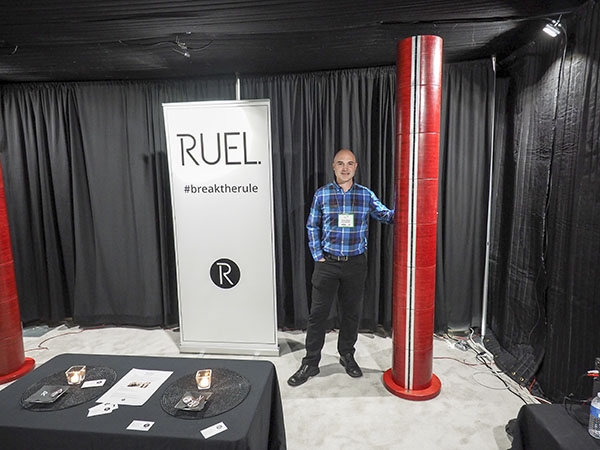
I was wondering what was up with the aluminium diffraction slot and found a close up of one element of the array:
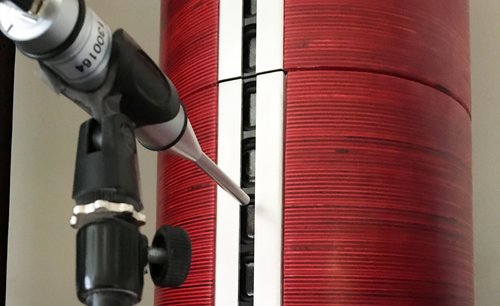
Now this 'may' be an older model as these pictures are from the R7 displayed in 2017. The R+ might be a little different.
It looks like there's 7 little drivers behind that slot in each part of the stack:
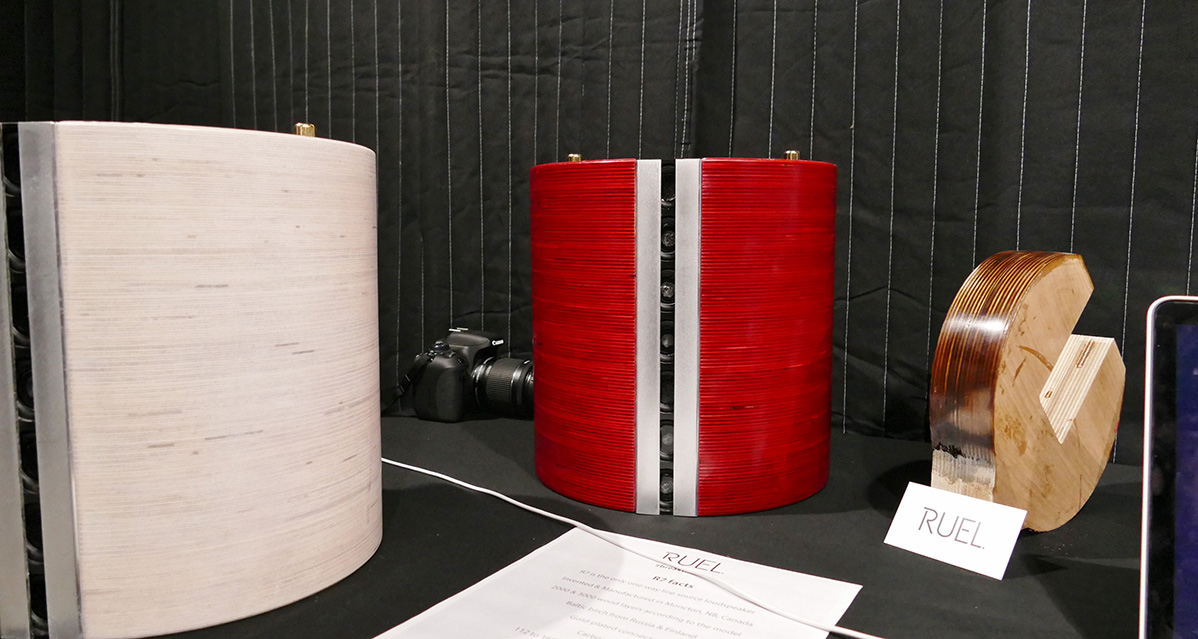
Another look at the diffraction slot:
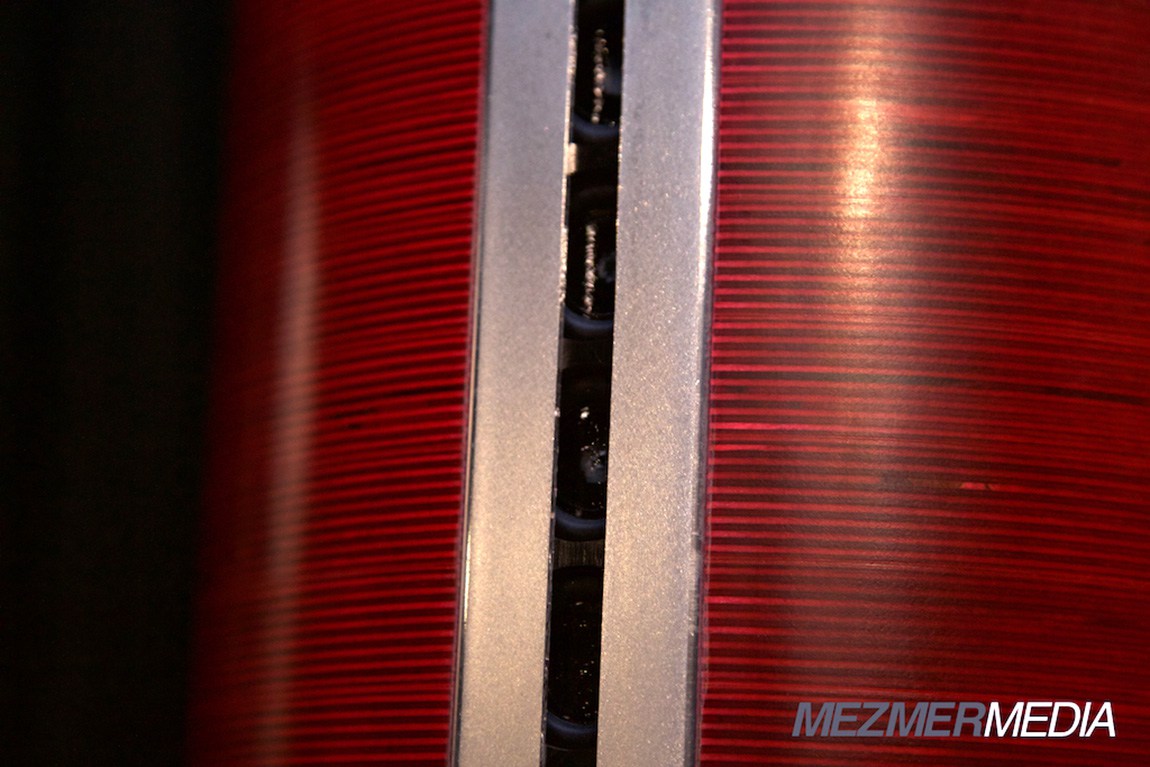
It kind reminded me of a 'very crude' Beveridge like construction, where Beveridge actually used vanes (as a lens) to go from a flat planar panel to the desired wave shape:
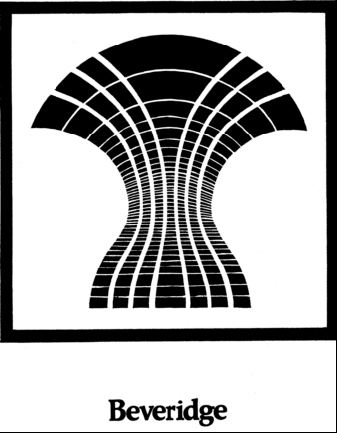
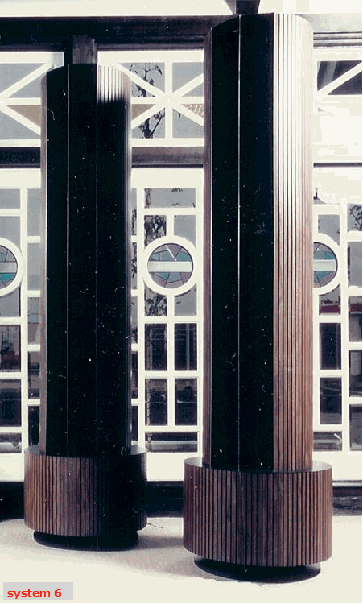
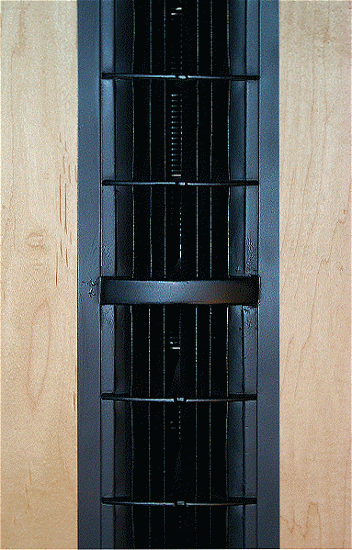
Anyway, more info here:
The R+ — RUEL
1000 watts of Hypex NCore and DSP included...
Quite recently, Mitch showed me a link to the Ruel R+ speakers. Line arrays with lots of little drivers, made from stackable Birch Ply parts.
Here's what it looks like:
I was wondering what was up with the aluminium diffraction slot and found a close up of one element of the array:
Now this 'may' be an older model as these pictures are from the R7 displayed in 2017. The R+ might be a little different.
It looks like there's 7 little drivers behind that slot in each part of the stack:
Another look at the diffraction slot:
It kind reminded me of a 'very crude' Beveridge like construction, where Beveridge actually used vanes (as a lens) to go from a flat planar panel to the desired wave shape:
Anyway, more info here:
The R+ — RUEL
1000 watts of Hypex NCore and DSP included...
Attachments
Last edited:
I think I found an explanation for my strange sound in the right channel. In the right side FIR file there's a strange anomaly in the original FIR correction that might explain what I heard.
There's a strange sine shape riding on top of the correction just under 10 KHz...

It was already present in the original DRC-FIR created correction. Now I need to find out why.
Amazing what one can hear... it sounded like a strange kind of buzzing in my right ear at times. I did wonder if it was my ear playing tricks on me as everything else sounded just fine.
There's a strange sine shape riding on top of the correction just under 10 KHz...
It was already present in the original DRC-FIR created correction. Now I need to find out why.
Amazing what one can hear... it sounded like a strange kind of buzzing in my right ear at times. I did wonder if it was my ear playing tricks on me as everything else sounded just fine.
Attachments
In the Ruel speakers, I'm assuming the drivers are 8Ω and that the modules of 7 are connected with the drivers in series, giving 56Ω per module or 7Ω for a stack of 8 or 4.7Ω for a stack of 12. I think this is quite clever.
What I don't understand is the reasoning behind the shape of the cross section of the module, if that's what is shown. Not only is the internal volume not exploited but the internal shape is far from optimal, with the reflective flat back surface and parallel reflecting surfaces on each side creating an inherently resonant volume with a strong standing waves, I would think.
Would anyone hazard a guess as to the identity of the driver?
What I don't understand is the reasoning behind the shape of the cross section of the module, if that's what is shown. Not only is the internal volume not exploited but the internal shape is far from optimal, with the reflective flat back surface and parallel reflecting surfaces on each side creating an inherently resonant volume with a strong standing waves, I would think.
Would anyone hazard a guess as to the identity of the driver?
- Home
- Loudspeakers
- Full Range
- The making of: The Two Towers (a 25 driver Full Range line array)
